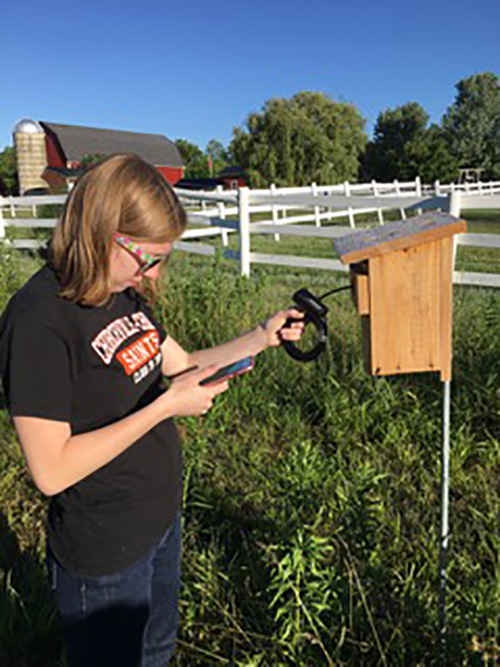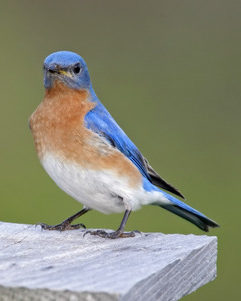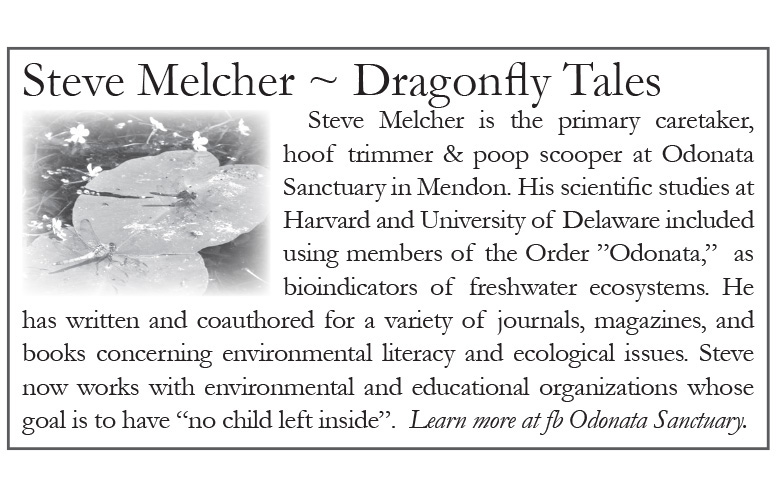Dragonfly Tales: Charlotte’s Web (cam)

by Steve Melcher –
 I’m writing this when there is frost on the inside of our windows here at Odonata Sanctuary. Remember those negative degree days, when schools were closed? Sorry for the reminder, but the dead of winter is the time “bluebird nestboxers”, those of us who maintain a trail of nestboxes specifically for bluebirds, are very concerned that these little balls of feathers keep their furnaces fully stoked. We’re not quite sure why the males stay around in the winter. Perhaps just another example of sexual dimorphism showing the female to be the more intelligent of the species. The females head south for warmer climes while the males stick around, possibly concerned that they’ll lose the territory they so vehemently fought for last spring. There were eight male Eastern Bluebirds at our mealworm feeder here at Odonata Sanctuary on that cold pre-Groundhog day; all vying for a chance to pop in through the specifically sized hole to grab a crispy, dried mealworm. That hole, 1 ½ inches, the same as on their nestboxes, needs to be constantly monitored for damage by foreign feathered invaders. If the hole is enlarged by the pecking away of predators, the mealworms, and perhaps the bluebirds, will disappear in a flash. One such bird pest, with a chainsaw-like bill is the European Starling (Sturnus vulgaris), revered in its native Europe, but a bane to nestboxers. I have to replace the ‘hole guard’ on my feeders at least twice during the winter. I’ve recently replaced one set with the proper sized hole drilled into leftover scraps from a hardwood floor project. These should last the rest of the season. The other non-native nasty pest is the House Sparrow (Passer domesticus), whose story of immigration is not as elegant as the Starling’s. The story of the Starling is that the chatty, black iridescent pirates were first introduced to Central Park by Eugene Schieffelin, then president of the American Acclimatization Society. The society’s goals were purportedly to ‘introduce every bird species mentioned in the works of William Shakespeare’ to the betterment of Olmsted’s masterpiece in New York City. About sixty common starlings were released into Central Park in 1890, and it’s been bedlam ever since. To this day one can ‘enjoy’ flocks of starlings, or murmurations as they are called, while trying to relax on the green at a performance at ‘Shakespeare in the Park’. The medium-sized passerines were also released in Oregon around the same time. Now Starlings are ubiquitous and considered an invasive species across the nation. House Sparrows, on the other hand, weren’t purposely introduced to enlighten or improve the culture of New York. Being primarily seed eaters, they just followed the leftover hayseeds in the abundant horse poop from ship to shore; probably coming across with the other hayseeds on the Mayflower. Starlings are the major ‘pest’ and ‘competition’ in the winter, along with lack of food and whatever else mother nature can muster. The story will change in the spring when the bluebirds are searching out nest boxes to set up housekeeping for the future family. In the spring, house sparrows are the major competition for nesting sites. Why do we have house sparrows here at Odonata Sanctuary? Unfortunately, wherever you have livestock, you’ll have house sparrows. The house sparrows eat the grain that is supposed to go to the critters. We built the barn and started the animal rescue farm and along came the house sparrows. I’ll spread out scratch grain for the geese over the water and the sparrows can actually swim underwater to get the grain on the bottom. House sparrows are very aggressive competitors when it comes to nesting sites. They’ll pull out the babies and adults or even build their nest right on top of an existing bluebird nest. I’ve found house sparrow nests with crushed bluebirds underneath. This is why nest box monitoring is so important. If you’re going to set up a bluebird nestbox, make sure it’s a design you can open and monitor for house sparrows. You don’t want to raise house sparrows, they’ll do fine on their own in the barn or somewhere else. One technique we have successfully used is to place the nest boxes in pairs. The pairs of nest boxes can be a few meters apart. The advantage of this pairing is that tree swallows (Tachycineta bicolor) will nest in the boxes as well. Swallows and bluebirds make great neighbors sharing a territory about half the size of a football field. These little blue and white dive bombers are the guardians of the bluebird galaxy. When a house sparrow approaches the nest boxes, the more timid bluebird retreats into its box while the tree swallow swoops down like a spitfire and chases the sparrow away.
I’m writing this when there is frost on the inside of our windows here at Odonata Sanctuary. Remember those negative degree days, when schools were closed? Sorry for the reminder, but the dead of winter is the time “bluebird nestboxers”, those of us who maintain a trail of nestboxes specifically for bluebirds, are very concerned that these little balls of feathers keep their furnaces fully stoked. We’re not quite sure why the males stay around in the winter. Perhaps just another example of sexual dimorphism showing the female to be the more intelligent of the species. The females head south for warmer climes while the males stick around, possibly concerned that they’ll lose the territory they so vehemently fought for last spring. There were eight male Eastern Bluebirds at our mealworm feeder here at Odonata Sanctuary on that cold pre-Groundhog day; all vying for a chance to pop in through the specifically sized hole to grab a crispy, dried mealworm. That hole, 1 ½ inches, the same as on their nestboxes, needs to be constantly monitored for damage by foreign feathered invaders. If the hole is enlarged by the pecking away of predators, the mealworms, and perhaps the bluebirds, will disappear in a flash. One such bird pest, with a chainsaw-like bill is the European Starling (Sturnus vulgaris), revered in its native Europe, but a bane to nestboxers. I have to replace the ‘hole guard’ on my feeders at least twice during the winter. I’ve recently replaced one set with the proper sized hole drilled into leftover scraps from a hardwood floor project. These should last the rest of the season. The other non-native nasty pest is the House Sparrow (Passer domesticus), whose story of immigration is not as elegant as the Starling’s. The story of the Starling is that the chatty, black iridescent pirates were first introduced to Central Park by Eugene Schieffelin, then president of the American Acclimatization Society. The society’s goals were purportedly to ‘introduce every bird species mentioned in the works of William Shakespeare’ to the betterment of Olmsted’s masterpiece in New York City. About sixty common starlings were released into Central Park in 1890, and it’s been bedlam ever since. To this day one can ‘enjoy’ flocks of starlings, or murmurations as they are called, while trying to relax on the green at a performance at ‘Shakespeare in the Park’. The medium-sized passerines were also released in Oregon around the same time. Now Starlings are ubiquitous and considered an invasive species across the nation. House Sparrows, on the other hand, weren’t purposely introduced to enlighten or improve the culture of New York. Being primarily seed eaters, they just followed the leftover hayseeds in the abundant horse poop from ship to shore; probably coming across with the other hayseeds on the Mayflower. Starlings are the major ‘pest’ and ‘competition’ in the winter, along with lack of food and whatever else mother nature can muster. The story will change in the spring when the bluebirds are searching out nest boxes to set up housekeeping for the future family. In the spring, house sparrows are the major competition for nesting sites. Why do we have house sparrows here at Odonata Sanctuary? Unfortunately, wherever you have livestock, you’ll have house sparrows. The house sparrows eat the grain that is supposed to go to the critters. We built the barn and started the animal rescue farm and along came the house sparrows. I’ll spread out scratch grain for the geese over the water and the sparrows can actually swim underwater to get the grain on the bottom. House sparrows are very aggressive competitors when it comes to nesting sites. They’ll pull out the babies and adults or even build their nest right on top of an existing bluebird nest. I’ve found house sparrow nests with crushed bluebirds underneath. This is why nest box monitoring is so important. If you’re going to set up a bluebird nestbox, make sure it’s a design you can open and monitor for house sparrows. You don’t want to raise house sparrows, they’ll do fine on their own in the barn or somewhere else. One technique we have successfully used is to place the nest boxes in pairs. The pairs of nest boxes can be a few meters apart. The advantage of this pairing is that tree swallows (Tachycineta bicolor) will nest in the boxes as well. Swallows and bluebirds make great neighbors sharing a territory about half the size of a football field. These little blue and white dive bombers are the guardians of the bluebird galaxy. When a house sparrow approaches the nest boxes, the more timid bluebird retreats into its box while the tree swallow swoops down like a spitfire and chases the sparrow away.
Last summer we had the privilege of helping a local Girl Scout obtain her Gold Award – the highest rank of achievement within Girl Scouts. Charlotte Spaulding had heard of Odonata Sanctuary through her dentist, Dr. Cheryl Kelley, a major supporter. Charlotte and her family and I got together for a picnic down by Willow Pond and we decided to extend a section of our bluebird trail and name it in her honor. Charlotte’s Trail consists of sixteen boxes that she and her cohorts constructed, erected and most importantly, monitored over the summer of 2018. We agreed on a design and she was able to obtain boards of beautiful western red cedar and hardware for the project donated by the Morse Lumber Company. After the nestboxes, C-01 through C-16, were installed in early July, she began the process of monitoring and recording data on their use.
Within a week, she had five bluebird eggs in one of the boxes. The following week there were several Tree Swallow eggs found in an adjacent box. What is unique about Charlotte’s monitoring method is the use of a endoscopic camera. Monitoring the nestbox is of utmost importance and involves opening the box, taking a quick peek, counting eggs, fledglings and hitchhikers and quickly, gently closing the door. The trick is to do all this with minimum disturbance. Checking the box is especially risky when the young birds are about to fledge. Disaster could result if you open the door and allow the fledglings to fly before they are truly ready. They may end up flapping into the field’s tall grass and become prey to all bird’s Public Enemy Number One: the common house cat….and that’s another story. By using an inexpensive endoscope attached to her smartphone, Charlotte may have solved the dilemma of ‘monitoring and nestbox disturbance’ and perhaps changed the monitoring techniques of future ‘nestboxers’ forever. She was able to insert the fiber optic camera and not only observe the occupants of the box but provide a record by taking a picture of the nest and contents. With a late start of July, Charlotte’s Trail was able to successfully fledge over twenty Eastern Bluebirds and a dozen Tree Swallows. Charlotte is well on her way to obtaining her Gold Star for scouts and has a possible ecology project to continue. The nests from her trail were collected and bagged after all had fledged and sent to Dr. Jack Warren of the University of Rochester where he studies a wasp that lives on a type of bot fly larvae that are found in the nests. I’m reminded of the song we sang in scouts many years ago: “The Green Grass Grew All Around…All Around,” which provides a musical illustration of Barry Commoner’s First Law of Ecology which is: ‘‘Everything is connected to everything else”. For example, there is group of entomologists from the Netherlands, cooperating with Dr. Warren, who are studying a mite that lives on the wasp that lays its eggs in the bot fly larvae that feeds on the baby bluebirds that live in the nest in the box that Charlotte built.
Further Reading:
The Bluebird Book: The Complete Guide to Attracting Bluebirds (A Stokes Backyard Nature Book)
Nestbox design: http://www.nabluebirdsociety.org/nestbox-plans/
The bluebirds need your help. They are like the ‘canaries in a coal mine’ advising us of environmental changes that may portend trouble ahead. Their numbers are increasing, primarily due to the efforts of bluebird advocates like Lawrence Zeleny, who became concerned with the fate of the Eastern Bluebird in the early ‘60’s and who is credited with founding the North American Bluebird Society in 1978 and to the growing number of bluebird trails, like the one in your own neighborhood at Odonata Sanctuary.
P.S. Odonata Sanctuary has a goal of 100 nest boxes on its 100 acres. We’re always looking for volunteers to help build the boxes and monitor the trail.
P.S.S. Charlotte Spaulding has been accepted (early decision) to the University of Rochester. Who knows? Her Gold Star may lead to a Ph.D
Odonata Sanctuary:
Odonata Sanctuary is a nature preserve, active farm and sanctuary where abandoned farm animals find a home to spend the rest of their days and Eastern Bluebirds, Meadowlarks, Bobolinks and Monarch Butterflies find suitable habitat to thrive. http://odonatafarmsanctuary.blogspot.com/
